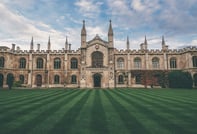Published on
Zombies in the Academy: Being Post-Death at Zombie University

The death of the university?
If much of the academic literature on higher education is to be believed, the university is, sadly, dead — a victim of the infectious creep of neo-liberal discourse. Texts such as “The University in Ruins” (Readings 1996), “Killing Thinking: The Death of the Universities” (Evans 2004) and “The death of the university, English style” (Couldry and McRobbie 2010) suggest that contemporary processes of governance and accountability have deadened the function of the university and the roles of those within it by stripping the university of its social, cultural and political meanings and imbuing it with a predominantly economic function. The claim, which is becoming increasingly widespread, is that universities of old were once provided their raison d’être by the nation-state, for which they produced an educated, engaged and critical citizenry (Readings 1996: 3). Societies, however, are becoming ever more global, no longer defined by geographical boundaries alone (Beck 2003), and universities are subsequently being “colonized” by governments’ international economic agendas (Kamola and Meyerhoff 2009: 5). Such agendas privilege “the rule of the cash-nexus” (Readings 1996: 3) over the idea of the university as a site for developing in students the capacity to be critical of their social conditions and “constraining relations” (Nicoll and Fejes 2008: 5). Knowledge is thereby becoming progressively commercialized (Shore 2010: 16) — a process often referred to as the “McDonaldization” of universities (Ritzer 1998). For many, these shifts mark an end to liberal education and the emergence of “audit culture” (Shore and Wright 1999). The idea of the university, then, might be thought of as a kind of “zombie concept” or a living/dead idea no longer representative of reality, but still “haunting people’s minds” (Beck 2000: 80).
For students in the contemporary massified environment who are being encouraged in increasing numbers to enter university, assertions that the university is dead have the potential to devalue their experience entirely, instead suggesting they have arrived on the scene too late and must settle for a decaying version of tertiary education. Taking a step back, however, the pervasiveness of neoliberal discourse is such that students are possibly already enfolded within its ideology; the same mechanisms that position the university as an “enterprising institution” (Reid 2009: 337) are likely to simultaneously position the student as a co-conspirator of sorts, who is complicit with, or at least aligned with, a zombified model of education. If this is the case, they may not be too upset about enrolling at ‘Zombie U.’
While the relationship between neoliberalism and university staff has been explored quite widely in the literature, the effects of neoliberalism on students have been the focus of less attention. The main observation is that neoliberal discourses have a worrying capacity for changing the relationship of the student to the university from one of learner to one of consumer, whereby the product they consume is their own educational transformation (Readings 1996: 27; Evans 2004: 96; Naidoo and Jamieson 2005). This shift in the way learners are positioned is particularly pronounced within narratives of social inclusion, which have been examined in some detail by Percy (2011). She suggests narratives of inclusion, while maintaining the “sentiment of democracy” (131), work to constitute students previously out of the reach of higher education “as an object of government,” and that they do so via an ideology of empowerment and freedom (133). They enable in the population greater levels of economic productivity through a set of discourses and practices that encourage individuals to “consume [their] way out of poverty” by investing in education (Percy 2011: 137). The social difference represented by students targeted by social-inclusion policies is not accommodated by universities, but rather problematized. Consequently, the role of universities and their learning support staff, in particular, is to “ameliorate the alienating distance between the students’ own cultural background and the cultural practices of the disciplines” (Percy 2011: 135). The outcome of this is students are ultimately positioned as products of the educational “machine,” emerging as “skilled and qualified bodies” that can be put to work in the global knowledge economy. Percy (2011: 135) describes these students as a “set of individuated capacities, dispositions and skills,” rather than people, per se, the product of a kind of governmental control Freire (1970: 77) has described as “necrophilic … [and] nourished by love of death.” Students, then, as objects upon which educational processes are enacted, might aptly be described as zombie learners.

To borrow a key phrase from Readings (1996), if the university is indeed dead, then survivors need to find a way to dwell within its ruins. The films of Romero provide a useful narrative here, as he has explored the possibilities and limits of surviving a post-apocalyptic landscape. Perhaps his most significant theme, reiterated ever more explicitly through “Night of the Living Dead” (1968), “Dawn of the Dead” (1978), “Day of the Dead” (1985) and “Land of the Dead” (2005), is that survivors of apocalypse should be deeply suspicious of dominant ideologies. Romero frequently creates stark divisions within groups of survivors in order to construct the main source of fear as emerging from other surviving humans rather than the zombies themselves (Bishop 2010a: 120). Typically, human survivors band together and lock themselves into a fortified space that becomes a refuge. It is usually somewhere exceedingly familiar and comfortable, and for that reason it encourages some survivors to stage a response to the Apocalypse based on survival of and within the status quo (Bishop 2010a: 104–05).
The spaces Romero uses across the four films are a family home, a shopping mall, a military bunker with scientific laboratories and a cramped metropolis; within these spaces, splinter groups fruitlessly try to rebuild the tattered past, and in doing so, recreate old divisions across race, gender and class lines. Their plans do not revolve around annihilating the zombie horde. Rather, labour goes towards the defence and preservation of dominant ideological and social structures (Bishop 2010a: 157). In barricading themselves away in order to revive the past, there is an utter denial of the transformations occurring around them that renders the survivors little more than zombies themselves, waiting out their existence and “going through the motions of a lost life” (Bishop 2010b: 242). What ultimately distinguishes those who survive beyond the final showdown is an appreciation that “the world has completely changed” (Romero, cited in Bishop 2010a: 30).
It is perhaps fitting that Readings echoes Romero’s message, asserting that dwelling in the ruins means avoiding nostalgia and any preoccupations with “rebuilding a ghost town” (Readings 1996: 169). It is vital for the subjects of higher education to think anew about the university and their being within it. This prompts us to embrace the apocalyptic moment as an opportunity to imagine an alternate future.
In a classic scene from Romero’s “Dawn of the Dead” (1978), two survivors sit quietly in a shopping mall watching zombies lurch from store to store, the muzak framing them as absurd and comical customers. One survivor asks, “What the hell are they?” The other replies, “They’re us, that’s all.” The point I have sought to make in this chapter is that zombies are not us, at least not yet. While the Bradley Report, and the broader neoliberal mechanisms of which it is a part, provide the prevailing discourse that currently brings people to, and positions them within, higher education, identities are not entirely constructed by these mechanisms. Abject bodies such as that of the zombie threaten the “I” and, therefore, simultaneously allow us to temporarily reaffirm it. As Larsen (2010: 1) suggests, “If the zombie is defined by ambiguity, it cannot be reduced to a negative presence. In fact, it could be a friend.” While this may be somewhat optimistic, Larsen’s point, and possibly my analysis here, may allow us to live alongside zombie discourses with a little less anxiety.
For Readings, what he saw as the death of the university generated deep feelings of ambivalence, and he wrote his influential text as “an attempt to think [his] way out of an impasse between militant radicalism and cynical despair” (1994: 5). It is difficult to deny the lurking presence of zombies in the academy, but I am not yet entirely convinced the university is dead, and neither are a number of other writers. Boyer (2010: 78), for example, asks and answers:
“Can we have reached the end of the project of liberal education, with only a post-liberal anxiety left … ? The very fact that we engage in critical scholarship challenges such pessimism.”
While it may seem simplistic to say so, the very act of creating critique such as that represented in this book indicates there is life in here still.
Instead of thinking about the university as dead, we might think of the higher education landscape as perpetually on the verge of apocalypse, which we hold back daily through our resistance to zombifying discourses. The way in which we might do this was glimpsed by Readings himself when he suggested that it may be enough that we are able to gain a degree of critical distance from our positions within the system to think about how we are being positioned to speak and act in certain ways (1994: 5). Percy supports this point also, suggesting that if agency is “embedded in the ethical project of self-formation and critique as we actively engage with the politics of truth about ourselves and the subject/object of our practices” (2011: 131), then we need to “live with a commitment to thought,” where thought is a form of reflexivity that allows us to step back from action, in order to examine their self-evidence and their contingency (Percy 2011: 139).
Indeed, I would suggest the way in which we exercise our being in this post-death university will emerge from moments of performativity, which provide glimpses into new ways of thinking about ourselves and what it means to exist in higher education. While performativity is often pointed to in the university as a sign of zombidity, in that it is the conduct of an action that seems inauthentic to us, the presence of consciousness problematizes the zombie label, and we free ourselves from zombidity with the awareness we are indeed caught up in a performance. The opportunity inherent in performativity has been observed by a number of other writers too. Gunn and Treat, for example, suggest that performativity generates “agential maps that enable us to locate its contradictions and constructedness” (2005: 163). Lather also sees its significance, as it emerges from “the between space of what seems impossible from the vantage point of our present regimes of meaning, a between space situated as an enabling site for working through … present practice” (2006: 45). In light of what zombie discourse can offer, as a catalyst of abjection, it is important to reconsider the concept of performativity in higher education as what Lather might describe as a “stuck place” rather than a dead end.
To purchase Zombies in the Academy, please click here.
Author Perspective: Administrator


